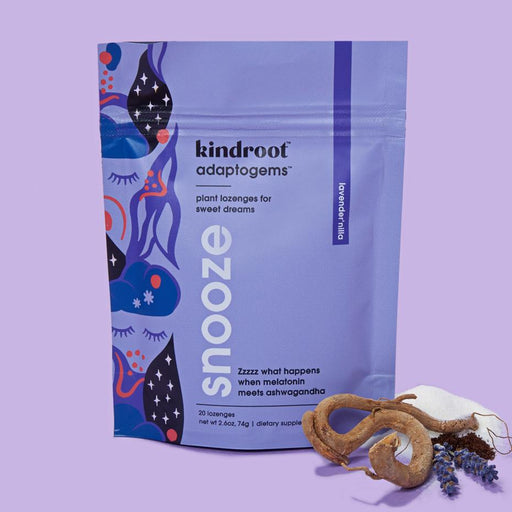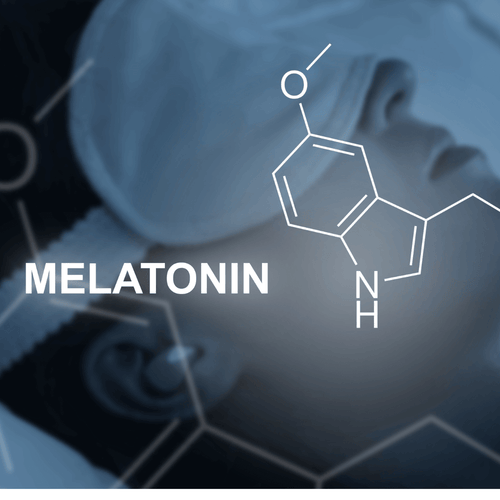Melatonin has long been touted as a way to prevent and recover from jet lag, so it’s no wonder that many people take melatonin supplements when flying. However, choosing the correct dose on the proper schedule can prove challenging if you’re new to melatonin. The following details how melatonin works and covers recommended doses so you can confidently take melatonin for jet lag.
Discover Kindroot Snooze: Melatonin + Ashwagandha Lozenges for Sleep
Contents
- Quick start guide
- Melatonin for jet lag: How it works
- When to take melatonin for jet lag
- Melatonin dosage for jet lag
- Is melatonin safe? The best melatonin for jet lag
- Can you take melatonin on a plane?
- Other jet lag tips and treatments
Melatonin for jet lag: Quick start guide

Melatonin for jet lag: How it works
Melatonin prevents and alleviates jet lag symptoms by helping your body regulate its circadian rhythm, which is often disrupted by long flights (especially those spanning two or more time zones).
Melatonin, the Ultimate Guide: Uses, Side Effects, Safety & FAQ
What is jet lag?
Everyone is subject to their circadian rhythm, a (roughly) 24-hour cycle of physiological and psychological conditions such as body temperature, blood pressure, heart rate, cognitive performance, alertness and sleepiness (Appleton Institute for Behavioural Science, Queensland University).
Our circadian rhythms are dictated by environmental signals called “zeitgebers,” and the most potent zeitgeber is sunlight. After a long flight, your circadian rhythm is still synched with the sunlight from where you departed, so you feel out of sync with where you landed.
Best over-the-counter sleep aids: What doctors say
“When there is an abrupt shift in the external environment, specifically in light patterns, through travel, there is a misalignment between your body’s internal cues, what your brain is observing, and often what you desire as a traveler,” says Kathryn Werner, PA-C, a mental wellness consultant who treats patients in her private practice (Kathryn Werner Wellness) and provides psychiatric medication management at White Pine Mental Health & Wellness.
For example, if you fly from New York at 8 p.m. on Thursday and land in Rome, Italy, at 10 a.m. on Friday, your internal clock is still operating as though it’s 4 a.m. That’s six hours behind your new local time, so while the Romans are bustling on a Friday morning, your body thinks you should still be in sweet slumber.

Jet lag symptoms include:
- Difficulty sleeping at night and waking in the morning
- Fatigue and difficulty staying awake during the day
- Poor sleep quality
- Impaired cognitive performance
- Headaches
- Anxiety
- Dizziness
- Nausea and digestive issues such as constipation or diarrhea
- General malaise
- Irritability
Jet lag can last a few hours or days, depending on multiple factors, but in general, you can expect:
- When flying east, the number of days it takes to recover from jet lag is approximately 1.5 days per time zone crossed. For example, if you cross three time zones, it will take up to 4.5 days to recover
- When flying west, the number of days it takes to recover from jet lag is approximately half a day per time zone crossed. For example, if you cross three time zones, it will take up to 1.5 days to recover

It’s important to note that those aren’t hard-and-fast rules, and you can recover faster if you take preventive measures.
“Duration is highly variable based on the direction of travel, the number of time zones crossed, the individual’s biology, and what the traveler does in preparation for or in response to the change. It can last a few days to a few weeks,” Werner explains. “A general rule of thumb is one-half to a day and a half of jet lag per time zone crossed. Use the shorter end of the range when calculating for westward travel or for fewer time zones traveled. Use the longer end of the range when considering eastward travel or more time zones.”
In general, jet lag is worse when flying east because you “lose time,” and it’s more difficult to get accustomed to staying up later than going to bed earlier.
Free Sleep Tracker: Track your sleep patterns & how they influence your day
“Many people find it easier to travel west than east. It’s easier to force yourself to stay awake a little longer than it is to force yourself to go to sleep earlier for several reasons: the excitement of being in a new place can stimulate wakefulness, the artificial light we have in our regular life has already habituated our bodies to be awake later in the day, and three out of four people have circadian rhythms that are slightly longer than 24 hours,” says Werner.
What is melatonin?
Melatonin is a hormone produced by the pineal gland. It plays a significant role in your circadian rhythm, as sunlight stimulates melatonin production and signals your body to wake, while darkness reduces melatonin production and signals your body to sleep.

That’s a simplified explanation, as your body’s circadian rhythm adapts to your lifestyle and melatonin onset begins around two hours before you normally go to sleep.
Unisom VS. Melatonin: Which is best for sleep?
“Our body’s rhythms are exquisitely timed with our external environment – most notably the rising and falling of the sun – through a part of the brain called the suprachiasmatic nucleus (SCN). The suprachiasmatic nucleus regulates the electrical and chemical activity of the neurons and creates sleep and wake signals based on this ‘circadian rhythm,’” says Werner. She explains that “circadian” literally means “about a day.”
Miss Luden’s Melatonin Soothers (Discontinued)? Compare to Kindroot Snooze
“More specifically, when bright light enters the eyes, it hits the retinal ganglion cells in the back of the eye, which signals the SCN and then the pineal gland to inhibit the release of tryptophan. So darkness allows the release of tryptophan. Through a series of reactions, tryptophan is converted to serotonin and then to melatonin, which drives sleepiness.”
How melatonin treats jet lag
“Crossing time zones disrupts our sleep cycle because our exposure to light and dark changes. Melatonin can be used to create a new sleep cycle or readjust to our former sleep cycle when we return home,” says Rebekah Delling, LMT, a certified sleep coach who owns Hypnotic Massage Sleep Boutique in Tryon, North Carolina.
Essentially, taking a melatonin supplement triggers the beginning of the sleep cycle. When traveling east, you can use melatonin to help you sleep earlier and adjust more quickly to your destination’s local time. When you’re traveling west, you can take melatonin to help you sleep later and – again – more quickly adjust to your new local time.
The best melatonin supplements, according to doctors

Indeed, multiple studies have shown that melatonin can reduce the effects of jet lag. According to one study, melatonin is “remarkably effective in preventing or reducing jet lag, and occasional short-term use appears to be safe. It should be recommended to adult travelers flying across five or more time zones, particularly in an easterly direction, and especially if they have experienced jet lag on previous journeys.”
When to take melatonin for jet lag
Werner recommends taking melatonin two to three hours before the time you’d like to fall asleep.
“Because melatonin is released by the pineal gland, deep in the brain, in response to darkness, it starts being released as early as dusk – two to three hours prior to sleep for most people, and then steadily increases until about 3 a.m. when it then decreases in preparation for waking,” she explains. “This can help you plan your melatonin schedules for maximum effectiveness.”
The best way to know precisely when to take melatonin for jet lag is to begin acclimating your body to your destination about a week before your flight, which allows you to try taking melatonin at different times until you identify a schedule that works.
Does melatonin help with anxiety? Here’s what doctors say
Here’s what Werner advises:
If you’re traveling east:
- Begin going to bed earlier slightly earlier each night, starting about a week before your flight
- Dim the lights and eat a meal with carbohydrates approximately three hours before bedtime
- Use blackout curtains or a sleep mask to maintain darkness while you sleep
- Take melatonin 1 to 3 hours before bedtime to help shift your sleep schedule
- When you wake, begin the day with bright light (full spectrum lighting for seasonal activity can prove helpful), exercise, and a low carbohydrate meal to set you up for success the following night
If you’re traveling west:
- Begin going to bed later and waking up later each day, starting about a week before your flight
- Leave the lights on longer, avoid evening carbohydrates and stay more active to combat fatigue
- If staying up late doesn’t tire you enough (some people experience a burst of energy when they stay awake past their usual bedtimes), take melatonin about an hour before you go to bed
What if you just want to sleep on the plane?
If you’re less worried about jet lag and simply want to sleep on the plane, you can take melatonin one to three hours before you want to fall asleep. If it’s a short flight, that might mean taking melatonin at the airport. If it’s a long flight, that might mean taking melatonin while you’re on the plane.
Can melatonin cause nightmares and dreams? What doctors say
As with preparing for jet lag, it’s best to experiment with melatonin at home before you fly.
“Dosage varies greatly between individuals. Plan to try melatonin before you’re stuck on a plane so you can determine a dose that helps you sleep but doesn’t make you overly tired,” says Werner. “Make sure you’ve got plenty of time to sleep on the flight, so you aren’t waking tired, groggy or disoriented.”

In addition, Werner cautions against combining melatonin with in-flight cocktails since the sedative properties of alcohol and melatonin combined could be unsafe. She also says those at risk for blood clots can use melatonin, but they should set an alarm to wake up every hour or so to move around and help prevent clots from forming.
Delling says some of her clients have reported that they experience a “melatonin hangover” if they don’t have time to get a full night’s sleep.
“Taking a smaller dose might reduce the risk, but some grogginess may still occur,” she says. “Combining melatonin with a stress-reducing herb like ashwagandha may also help with relaxation and sleep while in flight.”
Learn more about Kindroot Snooze, melatonin lozenges with ashwagandha
Melatonin dosage for jet lag
Melatonin supplements affect people differently, but 2 to 3 milligrams taken two to three hours before sleep is the ideal dose for most people.
Melatonin deficiency: Symptoms, causes & treatment options
In fact, larger doses can minimize the desired effects because they can trigger your brain to stop releasing its own melatonin.

“Small doses are best. Your brain will only produce as much melatonin as it needs, so larger doses of supplemental melatonin actually tell your brain to stop making as much,” Werner says. “Two to three milligrams is usually a sufficient dose to help you drift off to sleep without causing significant decreases in your natural production. Larger doses – 5 to 10 milligrams – used short-term for jet lag probably wouldn’t be hugely harmful, but why risk it when a smaller dose will probably get the job done?”
Can melatonin make you smarter? Here’s what doctors say
Again, it’s best to “practice” at home before your flight to identify the best dosage for you.
Is melatonin safe? What is the best melatonin for jet lag?
Melatonin supplements come in many forms, including:
- Pills and capsules
- Gummies
- Sprays
- Powders
- Tablets
- Lozenges
Note that melatonin isn’t regulated like medications, so it’s important to get yours from a trusted source with accurate dosages. Check labels for other ingredients, especially if you prefer vegan products or those made with organic ingredients.
“Melatonin is thought to be safe since it is something that the body naturally produces,” says Delling. “However, potential users should research brands and consult with their physician or pharmacist before taking any supplements. Parents should consult with their pediatrician before giving melatonin to their child.”
How melatonin boosts immunity, according to experts
Delling stresses the importance of research before choosing a melatonin supplement.
“I recommend that potential users do their research and not just buy whatever is cheapest,” she says. “Research brands that produce high-quality melatonin products, such as Kindroot, before consuming. I also recommend they speak with their doctor, naturopath, or pharmacist regarding dosage and to ensure safe usage.”

Can you take melatonin on a plane?
According to Transportation Security Administration (TSA) guidelines, you can take melatonin on a plane – both in your checked and carry-on bags. If you have more than 3.4 ounces of melatonin in liquid form, you must tell the security officer before you board the plane. You do not need to inform the officer if you have a “reasonable amount” of melatonin lozenges, gummies or pills. Learn more on the TSA website.
Other jet lag tips and treatments
You can consider these jet lag tips and treatments instead of or combined with melatonin.
Light and dark therapy
“Light and dark therapy is another highly effective way to treat and perhaps even prevent jet lag,” says Delling. “Exposure to bright light when one is trying to stay alert will tell the body it’s time to be awake. Exposure to pure darkness will indicate to the body that it’s time to sleep.”
She suggests using a sleep mask or blackout curtains to achieve the necessary darkness and to avoid LED lights. A light on the amber spectrum will not interfere with melatonin production if you need a little light.
Eat carbs to stimulate serotonin production
“Melatonin does not work alone. Serotonin is also important in sleep and is increased by carbohydrate consumption,” says Werner.
Eat a high-carb meal when you want to induce sleep, and eat low-carb meals when you want to stay awake.
Increase movement and exercise for wakefulness
Movement and exercise stimulate wakefulness, so incorporate time for activity into your schedule to help avoid the fatigue caused by jet lag.
“Movement is a great way to minimize the headaches, stiffness and fatigue associated with jet lag,” says Werner. “Increasing movements during hours of sunlight at your destination can help you adjust to the new time zone more easily and quickly.”
Drink plenty of water
Water keeps you hydrated, while alcohol and coffee can dehydrate you and worsen the effects of jet lag.
“The rigors of travel, as well as the dry plane air, lead to dehydration, which makes anyone feel crummy and can exacerbate jet lag symptoms as well as make it harder to sleep,” says Werner. “Staying well hydrated before, during and after travel can help. Avoid alcohol and caffeine, which can both negatively affect your sleep and how you feel.”
Prescription medications
Prescription medications such as zolpidem (Ambien), midazolam (Nayzilam) and eszopiclone (Lunesta) could help with jet lag. Speak to your doctor about safety and side effects if you’re interested in prescription medications.
Melatonin is a proven, safe way to prevent and overcome jet lag. As with any supplement, it’s best to practice taking melatonin at home to identify the best dosage and schedule. You can use melatonin alone or combine it with other treatments to reduce the effects of jet lag and arrive at your destination awake, refreshed and ready to seize the day.
Disclaimer: The information stated in this article is for educational purposes only. The information stated is not intended to treat, diagnose or cure any disease, condition, or other physical or mental ailment of the human body. The desire to make any changes to one's dietary habits or supplementation should be consulted and discussed with a licensed medical professional.




